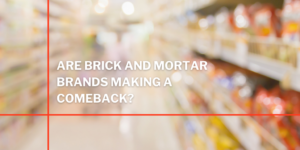
Are Brick and Mortar Brands Making a Comeback?
While digitally native brands are extremely performance-centric, traditional brick and mortar brands might be the silent assassins, adapting to the marketing and promotional style of D2C brands. We spent much of the pandemic reading that, to maintain customers, brick and mortar retailers must have an online buying option or perish at the hands of their digitally native competitors. But is that still true?

Fully D2C brands (you know them — Allbirds, Warby Parker, Glossier, etc.) have controlled a rising share of total retail sales since 2010. According to Forbes, online sales doubled as a percentage of total sales from 9.6% in 2009 to 19.6% in 2019. Then, D2C’s share jumped even more at the start of the pandemic to 25.5% in April 2020 as shoppers avoided going to stores (because, duh).
Then, a surge of bankruptcies (including Alex & Ani, Belk, Guitar Center, Lucky Brand, and DNC, among others) and store closures by major retail chains demonstrated the potency of the threat.
But brick and mortar brands are bouncing back.
Recent data shows that brick-and-mortar retail is demonstrating a surprising degree of resistance to this threat. Several digital-first brands think they can get shoppers back off their couches. Consumers are hybrid shoppers who expect multiple channels, online and off, to make a purchase. In fact, Allbirds found its hybrid customers spent 1.5x more.
D2C’s hold over the retail market has loosened over the last year, slipping back to 21.3% in December 2020, according to the Commerce Bureau. Rather than permanently destroying IRL retailers, the pandemic accelerated the growth of online sales and store closures that might otherwise have occurred over the next year or two.
Additionally, consumers remain starved for experiences and crave more than online shopping can offer. With almost two years of predominately shopping online, returning in-store customers are going to have a different set of expectations than before. The National Retail Federation anticipates that retail sales will grow up to 8.2 % this year, reaching more than $4.33 trillion.
And the world’s largest D2C brand, Amazon, is getting in on the action.
Last month, the e-commerce giant announced plans to launch a 30,000-square-foot brick-and-mortar fashion storefront called Amazon Style. It’ll be located in The Americana at Brand mall in Los Angeles next to traditional retail brands like Nordstrom, J. Crew, Urban Outfitters, and H&M. This isn’t Amazon’s first venture into brick-and-mortar spaces: It also owns and operates convenience store chain Amazon Go, Amazon 4-star, bookstore chain Amazon Books and Whole Foods Market.
According to the company, the Amazon Style floor will only feature one of each product for sale — much like a typical shoe store. Customers will scan an item’s QR code in an accompanying app to request different sizes or colors, which they can then pick up at a counter or in a fitting room that’s also equipped with touchscreens.
Amazon’s website offers countless items made by countless different fashion brands. The new storefront will have to pick and choose its inventory more sparingly.
So, while surviving brick-and-mortar brands may have overcome their largest hurdles already, they will have to adjust the ins-tore experience to be more exciting and experiential. In a post-pandemic world, consumers don’t want to sift through racks anymore. Instead, they’re looking for highly curated IRL endeavors.



